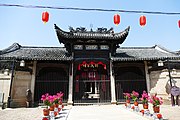Tangxi, Jinhua
Tangxi 汤溪镇 | |||||||
|---|---|---|---|---|---|---|---|
Town | |||||||
 View of Tangxi Town. | |||||||
| 29°03′20.16″N 119°23′40.92″E / 29.0556000°N 119.3947000°E / 29.0556000; 119.3947000 | |||||||
| Country | People's Republic of China | ||||||
| Province | Zhejiang | ||||||
| Prefecture-level city | Jinhua | ||||||
| District | Wucheng | ||||||
| Area | |||||||
| • Total | 106.82 km2 (41.24 sq mi) | ||||||
| Population (2017) | 62,900 | ||||||
| Time zone | UTC+08:00 (China Standard) | ||||||
| Postal code | 321075 | ||||||
| Area code | 0579 | ||||||
| Chinese name | |||||||
| Traditional Chinese | 湯溪鎮 | ||||||
| Simplified Chinese | 汤溪镇 | ||||||
| |||||||
Tangxi (Chinese: 汤溪镇<!—see MOS:ZH-->) is a rural town in Wucheng District of Jinhua, Zhejiang.[1] As of the 2017 census[update] it had a population of 62,900 and an area of 106.82-square-kilometre (41.24 sq mi).
History
The history of Tangxi Town dates back to the Neolithic Age.[2]
During the Spring and Autumn Period, Tangxi was under the jurisdiction of the Gumie Kingdom (Chinese: 姑蔑国).[2]
In 222 BC, Qin Shi Huang established Taiwei County (Chinese: 太未县) here. Later its name was changed into Longqiu County (Chinese: 龙丘县).[2]
In 931, during the Five Dynasties and Ten Kingdoms, Qian Liu founded the Wuyue Kingdom, Longqiu County was renamed Longyou County (Chinese: 龙游县).[2]
In 1471, in the 7th year of the Chenghua period of the Ming dynasty, Chenghua Emperor established Tangxi County (Chinese: 汤溪县) here.[2]
During the Guangxu reign of the Qing dynasty, American priest Weng Pixian (Chinese: 翁丕显) came here to spread Catholicism. Then priest Yi Wensi (Chinese: 伊文思) founded a Catholic church here.[2]
On December 28, 1958, Tangxi County was merged into Jinhua County (Chinese: 金华县).[2]
Geography
The highest point in the town is Mount Jiufeng.
Attractions
Tangxi Chenghuang Temple (Chinese: 城隍庙) is a folk temple and provincial level cultural heritage. It was first established in 1472, during the Ming dynasty, the modern temple was founded in 1866, in the late Qing dynasty.[3]
Jiufeng Temple is a Buddhist temple on Mount Jiufeng, it was built in 502, under the Liang dynasty. The present version was completed in the Qianlong period of the Qing dynasty.[2]
Notable people
- Tao Yuanming, poet in the Eastern Jin dynasty.
- Hu Sen (Chinese: 胡森), official in the Ming dynasty.
- Feng Zikai, painter.
- Wei Zuqing (Chinese: 魏祖清), mediciner.
Gallery
-
 Abandoned Waiting Room of Tangxi Railway station.
Abandoned Waiting Room of Tangxi Railway station. -
 Tangxi Chenghuang Temple.
Tangxi Chenghuang Temple. -
 Liu Clan Ancestral Hall.
Liu Clan Ancestral Hall. -
 Tangxi High School.
Tangxi High School.
References
- v
- t
- e
- Zhejiang Normal University
- Jinhua Polytechnic
- Jinhua No. 1 High School
- Yiwu High School















